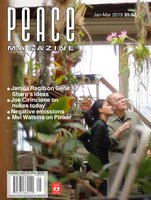
Peace Magazine Jan-Mar 2019, page 28. Some rights reserved.
Search for other articles by Ken Simons here
In the early 1980s, it was briefly one of the two richest countries in the world. Nauru’s citizens enjoyed a per capita yearly income of $50,000, thanks to a phosphate mining boom which lasted until the early 1990s.
But Nauru’s phosphate reserves are now gone; there is little foreign investment and negligible tourism.
Between 2001 and 2008, and again since 2012, Nauru has hosted an offshore detention centre on behalf of the Australian government. At its peak in August 2014, the Nauru Regional Processing Centre held 1,233 asylum seekers—roughly one detainee for every eight Nauru citizens.
The asylum claimants came mainly from Afghanistan, Iraq, Syria, and Somalia, and had been attempting to arrive in Australia by boat. However, due to a government policy known as “The Pacific Solution,” suspect ships would either be turned back to Indonesian ports or would be intercepted at sea. Claimants would then be taken for processing on naval vessels to Christmas Island, an Australian territory south of the Indonesian archipelago.
Christmas Island was unsuitable for the long-term detention of refugee claimants, whose processing could take years, rather than weeks or months. So longer-term facilities were set up on two remote islands: Manus (a province of Papua New Guinea) and Nauru.
For most of its existence, the Manus facility was considered the worse of the two offshore camps. In 2016, the Papua New Guinea government called for the camp to be closed, due in part to the high levels of physical and sexual violence—by guards, detainees, and local Manus residents.
A few hundred male detainees remained after the official closure, as they had nowhere else to go, and could not accept Australian offers of $25,000 to go back to their home country, where they would stand a good chance of being arrested or killed. Some detainees petitioned to be sent to Nauru, as it appeared to be the least-bad option at the time.
The Nauru detention centre is now Australia’s only remaining offshore facility for refugees. As of October 2018, there are approximately 900 asylum seekers in Nauru.
On October 7, 2018, the Nauru government expelled the medical and psychiatric staff of Médecins Sans Frontières (MSF) from the country. This is expected to have a catastrophic effect on the remaining detainees.
During the 11 months that MSF was on the island, more than 200 children and adults were treated for psychological problems. The team reports that 60 percent of the patients they saw had suicidal thoughts, and 30 percent had attempted suicide.
MSF has described the crisis as “extreme,” and calls on the Australian government to “end the [offshore detention] policy and immediately evacuate all refugees and asylum seekers—men, women, and children—from Nauru to avoid further deterioration of their health.”
MSF also treated Nauruan patients, who were similarly left behind by their own government’s expulsion order. Among this group, half were diagnosed as suffering psychosis.
Australia’s governing Liberal-National coalition and the opposition Labor Party both continue to back the “Pacific Solution” as a humane way to deal with asylum claimants who arrive by irregular means, and one which will ultimately deter the smugglers who profit from refugees’ desperation.
But after nearly 18 years of officially-sanctioned abuse, the political response may be changing. Opposition parties (including Labor, which stands a good chance of returning to power in 2019) are now backing legislation to allow detainees to receive medical treatment in Australia.
In September 2017, a judge approved $70 million in compensation to current and former Manus Island asylum seekers and refugees over their illegal detention in dangerous conditions. The Australian government has agreed to not contest the case.
Another pair of related lawsuits were filed in December 2018, alleging that the Australian government “subjected asylum seekers and refugees to torture, crimes against humanity and the intentional infliction of harm in operating its offshore processing system.”
Ken Simons is managing editor of Peace.

Peace Magazine Jan-Mar 2019, page 28. Some rights reserved.
Search for other articles by Ken Simons here